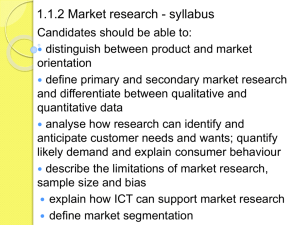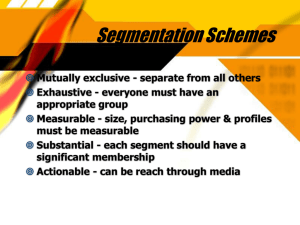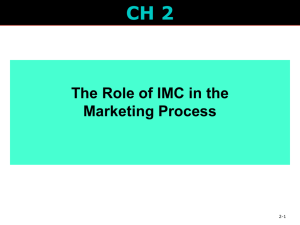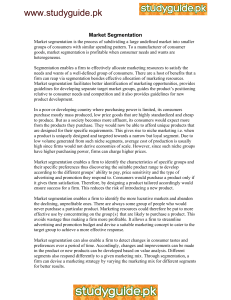SEM1 3.01 A - Market Planning PE – Select target market
advertisement
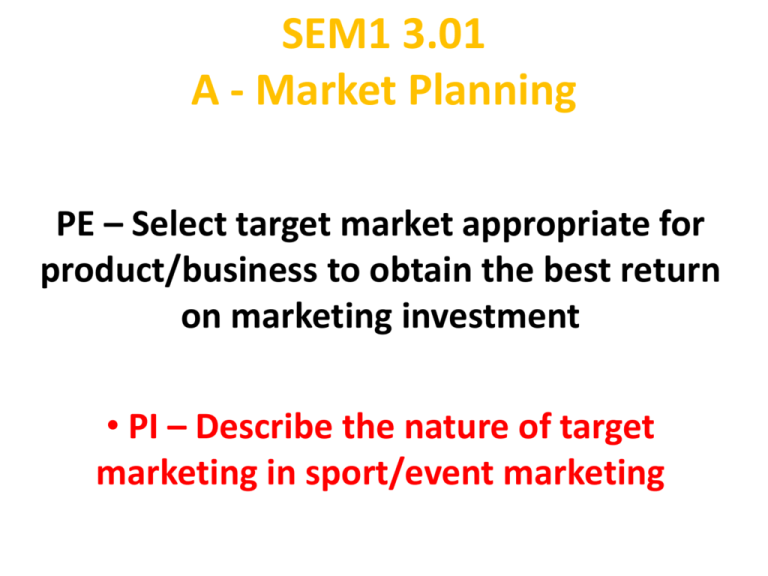
SEM1 3.01 A - Market Planning PE – Select target market appropriate for product/business to obtain the best return on marketing investment • PI – Describe the nature of target marketing in sport/event marketing Terms • Market – includes the group of all potential customers who share common needs • Target market – group of very specific customers that a company desires to have as consumers • Mass marketing – single marketing plan to reach all consumers – Ex: bottled water • Marketing segments – groups of unique individuals that share common characteristics • Market segmentation – dividing the entire market into smaller groups that share common characteristics & to create a target market – niche market would be an example The importance of target markets to SEM & why is it increasing • Provides them with a group of potential or existing customers in which to communicate – About their good or service to match, understand & satisfy customer needs – (leads to customer retention too!) – Who is buying, what do they buy and why do they buy – the more you know the better your product can satisfy those specific needs The importance of target markets to SEM & why is it increasing • Develop a specific, targeted marketing mix – Reflect differences in customer tastes & their needs – Increased sales & profits from each targeted market & more opportunities for growth – Make sure the customers you are targeting have the willingness and ability (disposable income) to purchase Describe advantages & disadvantages of using Market Segments • Advantages • Distinctive/Identifiable • Accessible/Actionable – Easy to get to • Measurable/Definable • Substantial – Large enough to make a difference • Stable – Will be around long enough for marketing to work • • • • • Disadvantages Wrong market Can’t reach them No real data Bad forecasts or information • Fads Describe advantages & disadvantages of Mass Marketing • Advantages • Less confusion – To implement – To customers • Less promotional cost • Less work – Strategic thinking – Manual hours • Disadvantages • Single message may not reach enough customers – May not keep pace with new trends • Lost sales opportunities – Harder and more costly to gain a new customer than to retain an old one Trends to smaller market segments 1950’s - Mass Marketing 1960’s Market Segments 1970’s Niche Marketing 1980’s Mass Customization 1990’s Micro-Marketing 2000’s E-Marketing Demographic Market Segmentation • Age • Generation – – – – Baby-boomers (‘46 – ’64) X (‘65 – ’76) Y (‘77 – ’93) Z (‘94 – ’04) techies • Gender • Family size • Family life cycle • Income – Disposable & Discretionary • • • • • • Occupation Education Ethnicity Nationality Religion Social Class Geographic Market Segmentation • Region: by continent, country, state, city, neighborhood or street • Size of metropolitan area: segmented according to size of population • Population density: often classified as urban, suburban or rural • Climate: according to weather patterns common to certain geographic regions Psychographic Market Segmentation • • • • • • • Activities Interests Opinions Attitudes Values Lifestyles What a person likes to do Behavioral Market Segmentation • Behavior towards a product; or the way they use a product • Benefits sought by the customer • Usage Rate – how often do they purchase? • Brand Loyalty – they expect something • User status – potential, first-time or regular • Readiness to buy – urgency • Occasions like holidays, birthdays & events that stimulate purchases







